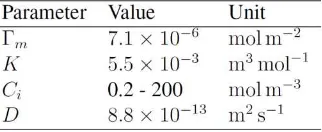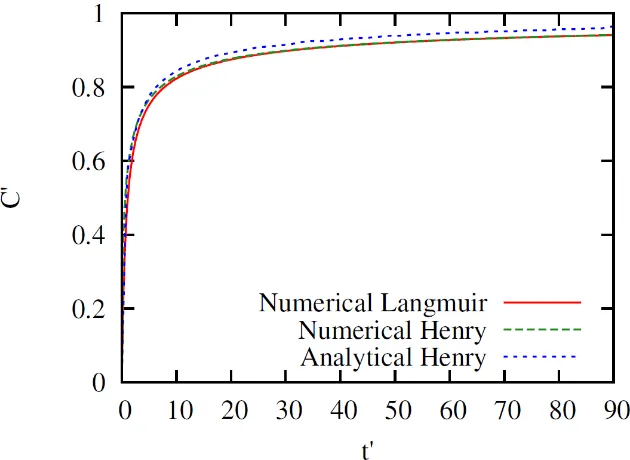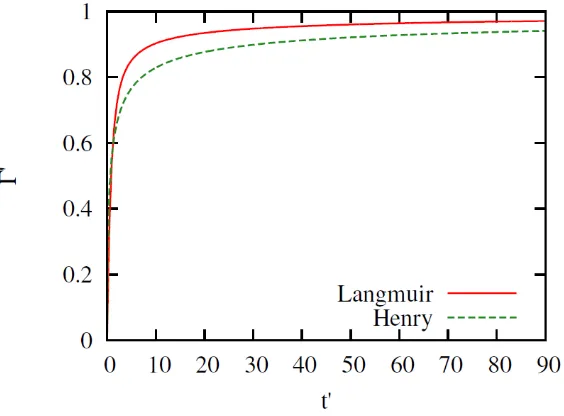DYNAMICS OF ADSORPTION OF SURFACTANT ON A BUBBLE SURFACE IN A FOAM FRACTIONATION COLUMN simulated mathematically. The model for the adsorption dynamics is developed based on the Fick’s Law and verified using the Ward-Tordai equation as well as analytical solution of the diffusion equation using Laplace transformation. The adsorption isotherm is modelled using the Henry isotherm and the Langmuir isotherm. The analytical solution using the Laplace transformation confirms the numerical solution using the Henry isotherm. Manipulation of the Laplace transformation of the diffusion equation using the Henry isotherm, and solution of the rearranged equation using convolution results in theWard-Tordai equation. At high bulk concentration, it is obtained that the adsorption rate using the Langmuir isotherm is greater than the adsorption rate using the Henry isotherm. At early time, the surface concentration is proportional to square root of time, a fact which is evident from direct inspection of the Ward-Tordai equation.
Keywords: adsorption, surfactant, bubble surface, Ward-Tordai equation
1. INTRODUCTION
Foam fractionation is an economical and environmentally friendly separation method for surface active material such as protein and/or surfactant (Burghoff, 2012) based on bubble separation techniques (Lemlich, 1968a). Foam fractionation can be conducted using semi batch or continuous processes (Lemlich, 1968b) using a foam fractionation column. The foam fractionation process is one of the alternatives for separation of dilute and structurally unstable material due to sensitivity towards changes of e.g. temperature or pH (Burghoff, 2012). This method is proven to be more cost-effective for the intended purpose compared to other methods such as ion exchange, electrophoresis, ultrafiltration and column chromatography (Burghoff, 2012; Gerken et al., 2006; Uraizee & Narsimhan, 1990) since it has simple operation, high efficiency and low energy consumption (Zhang, Wu, Yin, & Bai, 2010)
Foam in a foam fractionation column consists of air bubbles separated by thin liquid films (Weaire & Hutzler, 2001). Due to its amphiphilic nature, the surface active material is adsorbed onto the surface of the bubbles (Maldonado-Valderrama & Langevin, 2008). Since air bubbles have much lower density than the liquid, they will be lifted up to the top of the column carrying the surface active material with them. The enriched foamate is then collected from the top of the column. The amount of adsorbed material determines the efficiency of a foam fractionation column. The adsorbed materials also have a role to stabilise the liquid film, preventing the bubble coalescence and foam collapse by reducing the mobility of the film surface (Yeo, Matar, de Ortiz, & Hewitt, 2003). The design of a foam fractionation process needs to optimise the efficiency of the adsorption as well as the stability of the foam. This study examines the transfer of surfactant onto a bubble surface by adsorption. There are two steps of adsorption. The first step is diffusion of surfactant from the bulk solution to a layer next to the surface, named the subsurface layer. Once the surfactant molecules reach the subsurface layer, adsorption of surfactant from the subsurface to the bubble surface takes place (Chang & Franses, 1995).
K-32
numerically using a finite difference method. An analytical solution of the differential equation using Laplace transformation verifies the numerical models. The analytical solution only applies on simple model such as the case with the Henry isotherm. The equation using more complicated adsorption isotherm, such as the Langmuir isotherm can only be solved numerically. The Laplace transformation of the differential equation also results in a Ward-Tordai equation (Ward & Tordai, 1946), a common model for adsorption of surfactant on a bubble surface. The numerical solution is also compared with the solution of the Ward-Tordai equation. The simulations of adsorption dynamics are presented in dimensionless forms.
2. MATHEMATICAL MODEL OF THE ADSORPTION DYNAMICS
The diffusion of the surfactant from the bulk solution to the subsurface is rate limiting of the whole adsorption process. That diffusion follows the Fick’s law of diffusion as follows:
(1)
where is the concentration of surfactant at any given point in the bulk solution at any given time, is the time, is the distance from the bubble surface and is the diffusion coefficient of surfactant in the solution. The differential equation is solved using the boundary and initial
where is the surface concentration of surfactant on the bubble surface. The surfactant surface concentration is in equilibrium with the surfactant bulk concentration at the subsurface
, therefore the adsorption isotherm applies at this boundary. Commonly, adsorption of
surfactant onto a bubble surface is modelled using the Langmuir isotherm (Adamczyk & Petlicki, 1987) as follows:
(3)
where is the maximum surface concentration, represents the maximum packing on the interface [87] and is the Langmuir adsorption coefficient. The other boundary condition is taken at surfactant is initially zero. The initial bulk concentration of surfactant outside the subsurface is uniform and equals to the initial surfactant bulk concentration. Therefore, the initial conditions can be described as follow:
where is the initial bulk concentration of surfactant.
Dimensional analysis was carried out to determine the dimensionless forms of the adsorption dynamics as well as the boundary conditions. The dimensionless forms of the adsorption dynamics are as follow: distance from the bubble surface. The dimensionless form of the adsorption equilibrium at the gas-liquid interface is as follow:
( )
where is the dimensionless surface concentration of surfactant and is the dimensionless Langmuir adsorption coefficient. Using the Henry isotherm, in dimensionless form we can obtain , therefore we have:
(7)
The differential equation and the associated boundary and initial conditions are solved numerically. The result of the numerical simulation is then verified by the result of analytical simulation using Laplace transformation.
3. NUMERICAL SIMULATION OF WARD-TORDAI EQUATION
The results of the numerical solution are also compared with the result of an established equation for dynamics of adsorption on gas-liquid interface proposed byWard and Tordai (Ward & Tordai, 1946). In this chapter, only the Henry isotherm is used in the simulation using the Ward-Tordai equation. The equation is an analytical solution for the differential equation of adsorption dynamics as follows:
At first, the numerical simulation using the Langmuir isotherm is verified using the numerical simulation using the Henry isothem. An analytical solution of the differential equation using the Laplace transformation confirms the numerical solution using the Henry isotherm. The dimensionless form of the adsorption dynamics equation using the Langmuir and Henry isotherms are rescaled and the results of numerical simulation based on the rescaled parameters are compared with the results of simulation using the Ward-Tordai equation with a Henry isotherm. The values of the parameters used in this study are taken from the data of the study by Chang and Franses (Chang & Franses, 1995). The details of values of the parameters taken is presented in Table 1.
4.1. Verification of Numerical Solution
Numerical simulations of the dynamics of adsorption of surfactant on a bubble surface was carried out using the finite difference method. There are two different approaches to the adsorption isotherm. One simulation is using the Langmuir isotherm, while the other simulation is using the Henry isotherm. There are 1000 spatial steps used in the simulation, where the length of each dimensionless spatial step is 0.1 unit. The simulation was carried out to 100 unit of dimensionless time which is discretised into 1000 time steps. Therefore, each time step values 0.1 unit. The results of the numerical simulations are verified using the analytical solution using the Laplace transformation. Since the Laplace equation is too complicated to be inverted using the table of inverse Laplace transform, the inversion of the Laplace transformation is obtained numerically using the Fourier Fast Transformation.
K-32
The results of the simulation are presented in Figure 1. The analytical simulation using the Laplace transformation employs the boundary condition where the bulk concentration at infinite distance from the bubble surface is equal to the initial bulk concentration. This assumption does not apply to the numerical simulation, either using the Henry or the Langmuir isotherm. For the numerical simulations, one of the boundary conditions was set to 90 times of the characteristic length of adsorption (adsorption depth ) and a zero derivative of concentration was applied there . Due to those different approaches, there is a slight deviation of the simulation
result using analytical and numerical method. Another reason for the discrepancy is due to the error of the numerical inversion of the Laplace equation. The error of the Laplace inversion can be minimised by selecting more points when performing the Fourier Fast Transfer (FFT).
Figure 1. Dimensionless bulk concentration in the subsurface vs dimensionless time simulated using various methods and adsorption isotherms at very low initial bulk concentration. The analytical
result overestimates the numerical results due to numerical error.
The characteristic length h represents the characteristic distance over which surfactant molecules have to diffuse to supply the interface (Jin, Balasubramaniam, & Stebe, 2004). When a gas-liquid interface is formed, surfactant in the bulk immediately next to it will adsorb, resulting a depletion of the local concentration. As a consequence, surfactant diffuses from the bulk solution to supply this region. The distance where the diffusion starts to occur is the characteristic length (Ferri & Stebe, 2000).
The simulation presented in Figure 1 was carried out at very low initial bulk concentration
( ). At this low concentration, the Langmuir isotherm
will give a concentration profile very close to the profile given by the Henry isotherm as can be seen in Figure 1. Since the concentration at the surface is very small, its change will be insignificant to the adsorption isotherm. As a consequence, the Langmuir adsorption isotherm will behave similarly to the Henry isotherm.
4.2. Comparison of Simulations Using Langmuir and Henry Isotherms
When the result of simulation using the Langmuir isotherm at higher initial bulk concentration
( ). is compared to the simulation result using the
Figure 2. Dimensionless bulk concentration in the subsurface vs dimensionless time simulated using the Henry and Langmuir isotherms. The simulation is using while the other parameters are as presented in Table 1. The Henry model has more subsurface concentration than the Langmuir model.
Figure 3. Dimensionless surface concentration in the subsurface vs dimensionless time simulated using the Henry and Langmuir isotherms. The simulation is using while the other parameters are as presented in Table 1. The Langmuir model has more surface excess than the Henry
model.
K-32
3. From Figure 2 and Figure 3 it can be seen that the adsorption rate is greater for the Langmuir isotherm.
Figure 4. Rescaled dimensionless surface concentration vs dimensionless time simulated using the Langmuir and Henry isotherms compared with the simulation result using the Ward-Tordai
equation. The rescaling collapses the data at early times.
4.3. Numerical Simulation of Ward-Tordai equation
Figure 4 shows that the rescaled surface concentration calculated using the Henry isotherm matches the rescaled surface concentration calculated using the Langmuir isotherm at very early time. As time becomes longer, the surface concentration of the Langmuir isotherm differs from the surface concentration of the Henry isotherm. At longer times, there will be increasingly large values of calculated using both isotherms.
The value of is calculated numerically, using the finite difference method and the result is compared with the value of calculated using the Ward-Tordai equation. Both simulations are using the Henry isotherm. At early time, the surface concentration of surfactant is equivalent with the square root of time. In Figure 4, the value of obtained using the Ward-Tordai equation is slightly higher than that obtained using the Crank-Nicolson finite difference approximation. The small difference is possibly due to different boundary conditions taken for those two methods, or may be simply a result of the discretisation. The Ward-Tordai equation is obtained using a boundary condition of infinite diffusion length, while the Crank-Nicolson method of finite difference requires a finite diffusion length.
The simulation using the Ward and Tordai equation only provides concentration of surfactant on the surface and in the subsurface. On the other hand, simulation using the Crank-Nicolson finite difference method is able and need to simulate a concentration profile along the diffusion length. The profile of concentration along the adsorption length, however is not presented in this thesis Calculation of the concentration profile using the Crank-Nicolson method using the Langmuir isotherm takes four orders of magnitude longer time compared to the calculation using the Ward-Tordai equation. In this simulation, the computations were carried out for 100 unit of dimensionless time. For 1000 time steps, the simulation using the Ward-Tordai equation needed only 6 s to run, the numerical simulation (employing the diffusion equation) using the Henry isotherm needed 44 s, while the numerical simulation using the Langmuir isotherm needed 15 hr. The large difference on simulation time is because there are multiple loops to move through during the simulations using the finite difference method.
not provide the experimental data for the particular surfactant. Therefore, the verification of the numerical model in this study was carried out using the analytical method.
5. CONCLUSIONS
From the simulation results, it can be concluded that the analytical solution using the Laplace transformation confirms the numerical solution using the Henry isotherm. Manipulation of the Laplace transformation of the diffusion equation using the Henry isotherm, and solution of the rearranged equation using convolution results in theWard-Tordai equation.
It is also evident that the numerical solution using the Henry isotherm confirms the numerical solution of the Langmuir isotherm at a low surfactant concentration. Moreover, through comparison with Laplace transformation and with Ward-Tordai equation, the numerical solution for the equation of adsorption dynamics on foam surface is verified and applicable to both the Henry and Langmuir isotherms. At high bulk concentration, it is obtained that the adsorption rate using the Langmuir isotherm is greater than the adsorption rate using the Henry isotherm.
The simulation of adsorption dynamics using rescaled parameters using the Langmuir isotherm is verified by the simulation using the Henry isotherm at very early time. The results of the numerical simulation using the Crank-Nicolson method for a Henry isotherm are in accordance with the results of simulation of the Ward-Tordai equation using the Henry isotherm. At early time, the surface concentration is proportional to square root of time, a fact which is evident from direct inspection of the Ward-Tordai equation.
LIST OF SYMBOLS
= concentration of surfactant
= initial bulk concentration of surfactant
= dimensionless bulk concentration of surfactant = diffusion coefficient of surfactant in the solution = adsorption depth
= Langmuir adsorption coefficient = diffusion length
= time
= dimensionless time
= distance from the bubble surface
= dimensionless distance from the bubble surface
= surface concentration of surfactant on the bubble surface = maximum surface concentration
= equilibrium surface concentration of surfactant at a given initial bulk concentration = dimensionless surface concentration of surfactant
= dimensionless Langmuir adsorption coefficient
REFERENCES
Adamczyk, Z., & Petlicki, J. (1987). Adsorption and desorption kinetics of molecules and colloidal particles. Journal of Colloid and Interface Science, 118(1), 20–49. doi:DOI: 10.1016/0021-9797(87)90433-4
Adamson, A. W., & Gast, A. P. (1997). Physical chemistry of surfaces. Wiley.
Borwankar, R. P., & Wasan, D. T. (1988). Equilibrium and dynamics of adsorption of surfactants at fluid-fluid interfaces. Chemical Engineering Science, 43(6), 1323–1337.
K-32
Chang, C. H., & Franses, E. I. (1995). Adsorption dynamics of surfactants at the air/water interface: A critical review of mathematical models, data, and mechanisms. Colloids and Surfaces A: Physicochemical and Engineering Aspects, 100, 1–45.
Ferri, J. K., & Stebe, K. J. (2000). Which surfactants reduce surface tension faster? {A} scaling argument for diffusion-controlled adsorption. Advances in Colloid and Interface Science, 85(1), 61–97. doi:DOI: 10.1016/S0001-8686(99)00027-5
Fick, A. (1855). On liquid diffusion. The London, Edinburgh, and Dublin Philosophical Magazine and Journal of Science, 10(63), 30–39.
Gerken, B. M., Nicolai, A., Linke, D., Zorn, H., Berger, R. G., & Parlar, H. (2006). Effective enrichment and recovery of laccase C using continuous foam fractionation. Separation and Purification Technology, 49(3), 291–294. doi:http://dx.doi.org/10.1016/j.seppur.2005.09.015
Jin, F., Balasubramaniam, R., & Stebe, K. J. (2004). Surfactant Adsorption To Spherical Particles: the Intrinsic Length Scale Governing the Shift From Diffusion To Kinetic-Controlled Mass Transfer. The Journal of Adhesion, 80(932319487), 773–796. doi:10.1080/00218460490480770
Lemlich, R. (1968a). Adsorptive Bubble Separation Methods: Foam Fractionation and Allied Techniques. Industrial and Engineering Chemistry, 60(10), 16–29.
Lemlich, R. (1968b). Principles of Foam Fractionation. In E. S. Perry (Ed.), Progress in Separation and Purification (Vol. 1, pp. 1–56). New York: Interscience.
Maldonado-Valderrama, J., & Langevin, D. (2008). On the Difference between Foams Stabilized by
Surfactants and Whole Casein or β-Casein. Comparison of Foams, Foam Films, and Liquid Surfaces Studies. The Journal of Physical Chemistry B, 112(13), 3989–3996. doi:10.1021/jp7112686
Uraizee, F., & Narsimhan, G. (1990). Foam fractionation of proteins and enzymes: I. Applications. Enzyme and Microbial Technology, 12(3), 232–233. doi:DOI: 10.1016/0141-0229(90)90045-R
Ward, A. F. H., & Tordai, L. (1946). Time-Dependence of Boundary Tensions of Solutions I. The Role of Diffusion in Time-Effects. Journal of Chemical Physics, 14(7), 453–461. doi:10.1063/1.1724167
Weaire, D. L., & Hutzler, S. (2001). The Physics of Foams. Oxford University Press.
Yeo, L. Y., Matar, O. K., de Ortiz, E. S. P., & Hewitt, G. F. (2003). Film drainage between two surfactant-coated drops colliding at constant approach velocity. Journal of Colloid and Interface Science, 257, 93–107. doi:http://dx.doi.org/10.1016/S0021-9797(02)00033-4



